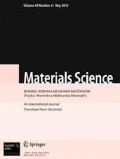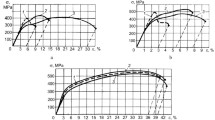We establish the macro- and microfractographic features of the tensile fracture of cylindrical specimens made of nitinol (Ni–Ti alloy) at room temperature and at 0°C caused by their preliminary electrolytic hydrogenation. The revealed hydrogen embrittlement of the metal was associated with the facilitation of martensite transformation, which is more clearly pronounced at the lower testing temperature. This explains the phenomenon of reorientation of the macroscopic fracture surfaces of specimens from the tensile mode into the shear mode under the influence of the conditions of embrittlement. On the microlevel, the appearance of brittle cleavages along the boundaries of martensite crystals is regarded as a specific feature of the fracture of nitinol caused by its hydrogenation. Under more severe hydrogenation conditions, the width of the cleavage zone in the subsurface layers of the specimens increases, which is explained by the deeper penetration of hydrogen into the metal favorable for the structural and phase transformations.



Similar content being viewed by others
References
D. J. Hartl and D. C. Lagoudas, “Aerospace applications of shape memory alloys,” Proc. Inst. Mech. Eng.: J. Aerospace Eng.,221, Part G, 535–582 (2007).
V. P. Iasnii and R. Junga, “Phase transformations and mechanical properties of the nitinol alloy with shape memory,” Fiz.-Khim. Mekh. Mater.,54, No. 3, 107–111 (2018); English translation:Mater. Sci.,54, No. 3, 406–411 (2018).
F. Gamaoun, M. Ltaief, T. Bouraoui, and T. Ben Zineb, “Effect of hydrogen on the tensile strength of aged Ni–Ti superelastic alloy,” J. Intelligent Mater. Syst. Struct.,22, No. 17, 2053–2059 (2011).
F. Gamaoun, I. Skhiri, T. Bouraoui, and T. Ben Zineb, “Hydrogen effect on the austenite–martensite transformation of the cycled Ni–Ti alloy,” J. Intelligent Mater. Syst. Struct.,25, No. 8, 980–988 (2014).
T. Ogawa, E. Yokozawa, T. Oda, K. Maruoka, and J. Sakai, “Hydrogen embrittlement behavior of Ni–Ti shape memory alloy with different microstructures in acidic fluoride solution,” Int. J. Mech. Mater. Eng. (A Springer Open J.),10, No. 12, 1–10 (2015).
I. Kireeva, Yu. Platonova, and Yu. Chumlyakov, “Effect of hydrogen on the two-way shape memory effect in TiNi single crystals,” in: S. Belyaev, S. Prokoshkin, A. Razov, A. Volkov, and N. Resnina (editors), Proc. of the Second Conf. “Shape Memory Alloys,” SMA 2016 (Saint Petersburg, Russia, 2016), Mater. Today,4, No. 3, Part B, 4773–4777 (2017).
V. P. Iasnii, H. M. Nykyforchyn, O. T. Tsyrul’nyk, and O. Z. Student, “Specific features of deformation of the nitinol alloy after electrolytic hydrogenation,” Fiz.-Khim. Mekh. Mater.,54, No. 4, 124–130 (2018); English translation:Mater. Sci.,54, No. 4, 582–588 (2019).
V. Iasnii, P. Yasniy, Y. Lapusta, and T. Shnitsar, “Experimental study of pseudoelastic NiTi alloy under cyclic loading,” Sci. J. TNTU,92, No. 4, 7–13 (2018).
I. Chattoraj, “The effect of hydrogen induced cracking on the integrity of steel components,” Sadhana,20, No. 1, 199–211 (1995).
P. Bastien and P. Azou, “Influence de l'amplitude et de la vitesse des déformations plastiques sur la ségrégation de l’hydrogène dans le fer et les aciers,” Compte Rendus,232, 69–71 (1951).
H. H. Johnson and J. P. Hirth, “Internal hydrogen supersaturation produced by dislocation transport,” Metall. Trans., A,7, No. 10, 1543–1548 (1976).
Author information
Authors and Affiliations
Corresponding author
Additional information
Translated from Fizyko-Khimichna Mekhanika Materialiv, Vol. 55, No. 3, pp. 80–85, May–June, 2019.
Rights and permissions
About this article
Cite this article
Iasnii, V.P., Student, O.Z. & Nykyforchyn, H.М. Influence of Hydrogenation on the Character of Fracture of Nitinol Alloy in Tension. Mater Sci 55, 386–391 (2019). https://doi.org/10.1007/s11003-019-00314-y
Received:
Published:
Issue Date:
DOI: https://doi.org/10.1007/s11003-019-00314-y




